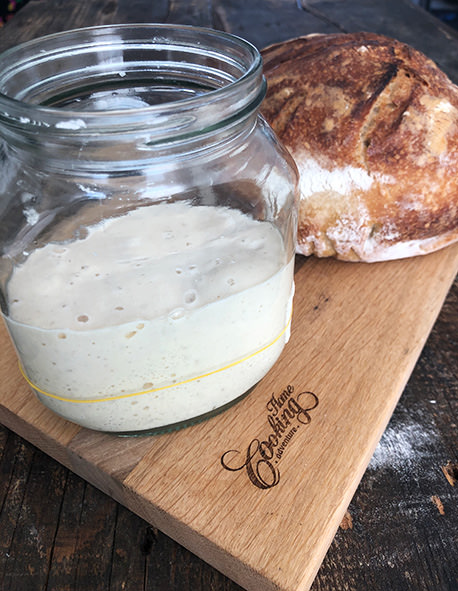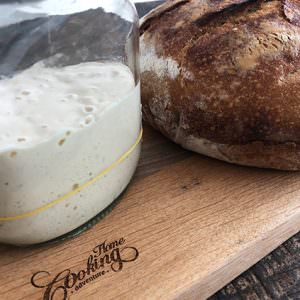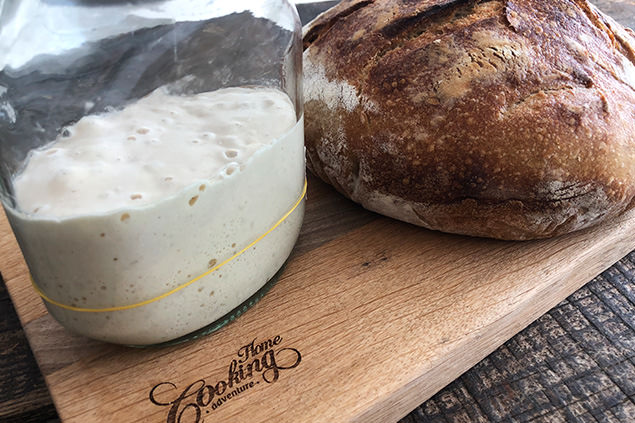I made my Sourdough Starter from Scratch 8 years ago. Since then, I feed it regularly and try to bake sourdough bread whenever I have the chance. I simply love the whole process and there is no way back for me. All started as a challenge, as it was hard to believe that bread could be baked without using commercial yeast at all, and have such amazing results even in the home oven.
I knew that this was the way our grandparents were actually baking bread many years ago when yeast was hard to find, so I wanted to try it for myself. The sourdough starter I made followed exactly the steps shown below. It worked for me from the first time. All you need for starting your own starter is water and flour. Simply follow all the steps and will definitely work for you and in no more than 7 days you will be able to bake your first sourdough bread with your own Sourdough Starter from Scratch. I am sure you will feel the same as I do, you will never turn back to classic yeast bread ever again. Happy baking!

RELATED POSTS:
Easy Sourdough Bread
50 Percent Whole-Wheat Sourdough Bread
Sourdough Barley Bread

Sourdough Starter from Scratch
Ingredients
- White Bread flour
- Rye Flour
- Bottled water , lukewarm
Instructions
- Day 1, in the morning: In a bowl mix 100 g water, 50 g rye flour, and 50 g white flour. Transfer into a clean jar, cover loosely, and leave the culture at room temperature (warm spot) for 24 hours.
- Day 2 in the morning: You should see some bubbles in it. Discard all but 75 g of the culture which you transfer into a clean bowl. Feed this with 75 g water, 25 g rye flour, and 50 g white flour. Wash the jar with simply warm water and transfer the culture into the jar. covered loosely. Let it sit at room temperature (warm spot) for 12 hours.
- Day 2 in the evening: Even if the signs of activity might not be visible, repeat the process as in the morning, discarding all but 75 g of the culture which you transfer into a clean bowl. Feed this again with 75 g water, 25 g rye flour, and 50 g white flour. Transfer to the clean jar, cover loosely, and let it sit at room temperature (warm spot) for 12 hours.
- Day 3 – repeat feeding the culture every 12 hours as in day 2, 75 g culture, 75 g water, 25 g rye flour, and 50g white flour.
- Day 4: On day 4 you may see visible signs of life, the culture is bubbly and raised in volume. Continue feeding every 12 hours, same ratios as in previous days.
- Day 5: Once the starter doubles in volume you can feed the starter using only white bread flour. So it will be 75 g starter, 75 g water, and 75g white bread flour, which is 1:1:1 ratio (equal amounts of starter, water and flour). Repeat feeding the starter every 12 hours.
- Day 6-7: From this moment you have a 100% hydration starter, that is bubbly and has a sour smell, that doubles in 8 hours or less, that should be strong enough to be able to bake your first sourdough bread. You have succeeded!
- Repeat feeding the starter every 12 hours for 14 days to make it stronger. Sourdough starter will rise and deflate between feedings and it gets stronger and active with each feeding process.
- How to maintain and store your starter.
- After the first 14 days of regularly feeding you can consider either to store it at room temperature or refrigerating it. If storing at room temperature, daily feedings will be necessary.You should consider keeping it at room temperature if you intend to bake bread almost daily. If not, refrigerating it might be the best storing option. If refrigerating, the sourdough starter needs a weekly feeding process even if you intend to bake bread or not.
- After the first 14 days the starter is active enough and doubles or triples pretty fast. It’s time to change the ratio so you can keep the feeding process to every 12 hours. So you can consider feeding the starter to a ratio of 1:3:3. I use around 20g of starter, discard the rest and mix with 60g water and 60g bread flour.
- If refrigerated, let it to get to room temperature for 1 hour before feeding it. Feed twice, once in the evening and again in the morning after 12 hours, ratio 1:3:3, let it rise and then you can refrigerate again. Repeat these steps each week.
- The best time to remove the starter for creating the levain for bread is after the second feeding, when it is at its peaks, not deflated. Remove in a bowl the amount of starter needed in the recipe, and refrigerate the rest.
Did you make this recipe?
Please let me know how it turned out for you! Leave a comment below and tag @homecookingadventure on Instagram and hashtag it #homecookingadventure.


Hi Ella,
Many thanks for all your efforts to share such great recipes that are beautiful and delighted other than deliciousness that has come along with an artistic flair and professional presentation.
I have made this sourdough starter based on your structure, but it raised before the first 24 hours. It’s tripled now and also bubbling. Is it normal? As this is my 5th try (My first try with your receipt) I don’t want to fail anymore.
Should I feed it before 24 hours?
It’s really amazing recipe but please I need a video for it because I didn’t understand the process of preparing the sourdough starter
Hi! Between the first and second feeding for refrigerated starter, do you put it back in the fridge? Thank you! 🙂
Hello from Ukraine!
Everything you do is perfect. I`ve tried a lot from your recipes and everything went great.
When you feed your starter do you leave it in a dark place or it doesn`t matter?
Curious why rye? Could you sub another flour?